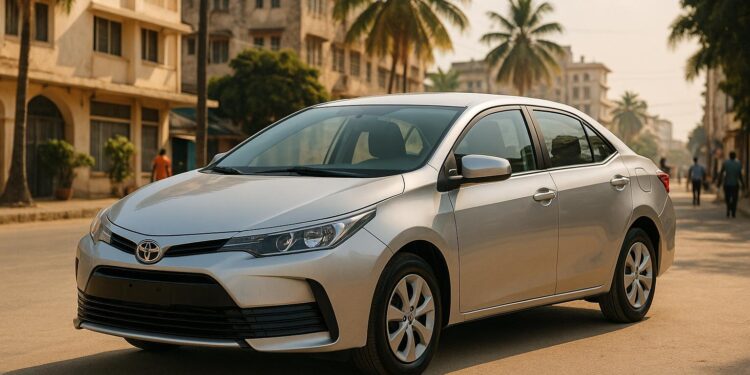If you’re driving for Uber, Bolt, or taxi services in Tanzania, choosing the right car is crucial. The best vehicles balance fuel efficiency, reliability, affordability, and passenger comfort – all while meeting regulatory requirements. Here’s a quick rundown of the top choices:
- Toyota Corolla: Reliable, fuel-efficient (32–58 MPG), and low maintenance. Offers comfort and durability, making it ideal for long-term use.
- Toyota Premio: Combines mid-luxury comfort with solid fuel economy (28–37 MPG) and low maintenance costs.
- Toyota Passo: Compact and budget-friendly with excellent fuel efficiency (up to 28 km/L). Great for new drivers.
- Nissan Note: Hybrid technology delivers exceptional fuel savings (59–71 MPG) and a spacious interior.
- Honda Fit: Highly fuel-efficient (47–80 MPG), reliable, and versatile with flexible seating.
- Suzuki Alto: Affordable and highly fuel-efficient (22–26 km/L). Perfect for city driving on a budget.
- Toyota Vitz: Compact, dependable, and fuel-efficient (18–25 km/L). Easy to maneuver in urban areas.
- Mazda Demio: Fuel-efficient (4.9 L/100 km) and low maintenance. A practical choice for daily operations.
- Toyota Axio: Durable, comfortable, and fuel-efficient (18–24 km/L). Great for long trips and rough roads.
- Hyundai Accent: Solid fuel economy (28–35 MPG) with low maintenance costs. A dependable sedan option.
Each car offers unique benefits depending on your budget, driving conditions, and passenger needs. Below is a quick comparison to help you decide.
Quick Comparison
| Model | Price Range (TZS) | Fuel Economy (km/L) | Key Features | Main Drawback |
|---|---|---|---|---|
| Toyota Corolla | 250,000+ (used) | 13.6–24.6 | Reliable, low maintenance | Higher upfront cost |
| Toyota Premio | 20M–40M | 11.9–15.7 | Comfortable, durable | Premium price range |
| Toyota Passo | 8M–20M | 15.4–28 | Budget-friendly, compact | Limited space for passengers |
| Nissan Note | 25M–35M | 25–30 | Hybrid efficiency, roomy | Expensive upfront |
| Honda Fit | 15M–22M | 20–34 | Flexible seating, reliable | Higher maintenance costs |
| Suzuki Alto | 10M–15M | 22–26 | Affordable, low running costs | Small passenger capacity |
| Toyota Vitz | 12M–18M | 18–25 | Compact, easy to drive | Struggles on rough roads |
| Mazda Demio | 15M–22M | 20–30 | Fuel-efficient, low maintenance | Tight rear legroom |
| Toyota Axio | 20M–30M | 18–24 | Durable, spacious | Higher upfront cost |
| Hyundai Accent | 20M–30M | 11.9–15.7 | Low maintenance, dependable | Limited availability locally |
Key Takeaway: For budget-conscious drivers, the Suzuki Alto and Toyota Passo are great options. If you’re prioritizing long-term savings and passenger comfort, consider the Toyota Corolla, Premio, or Axio. Hybrid options like the Nissan Note are ideal for eco-conscious drivers looking for fuel savings.
The Most Suitable Cars for the Taxi Business in Kenya, Hybrid and Non-hybrid Categories
1. Toyota Corolla
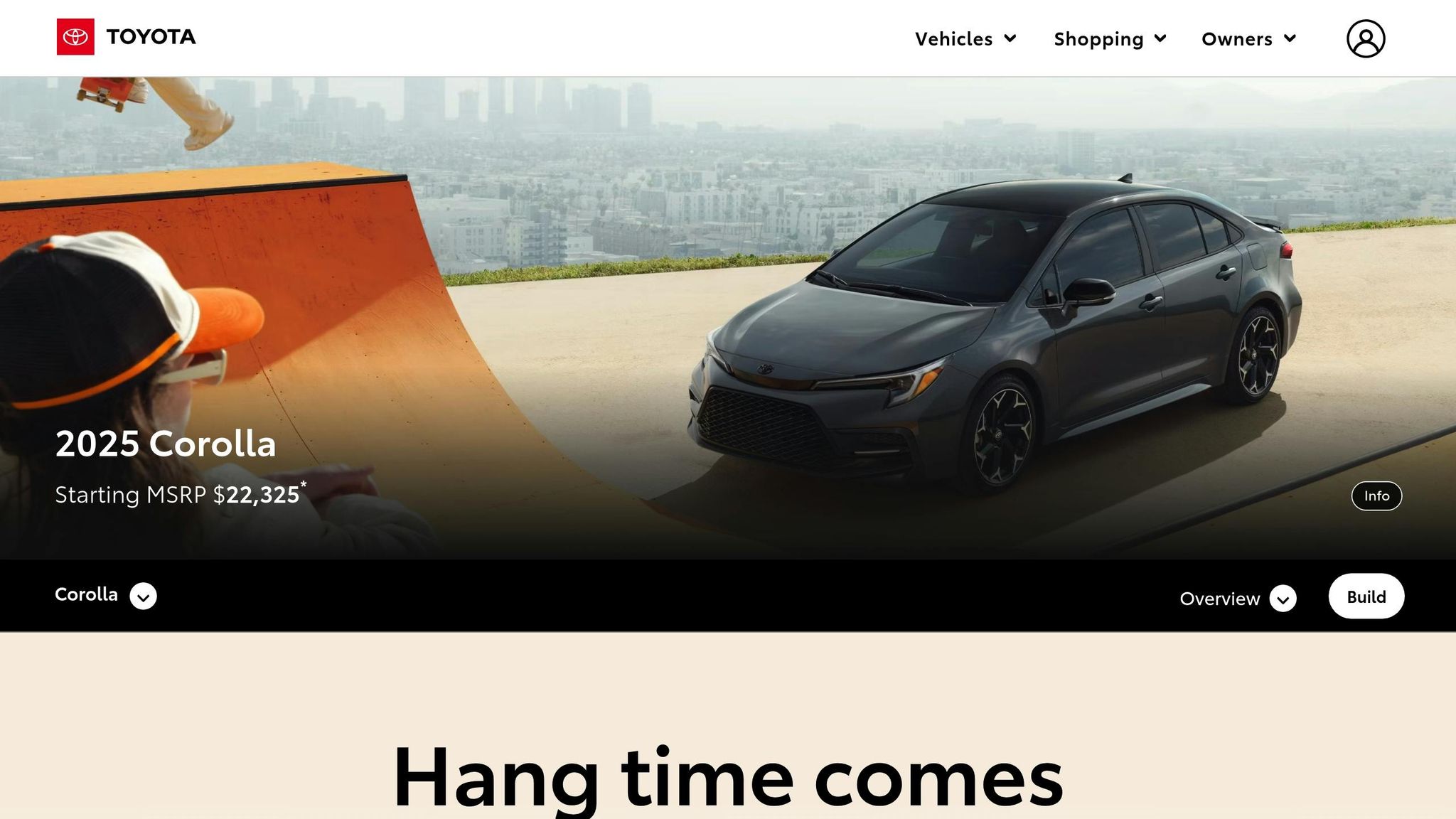
The Toyota Corolla holds the title of the world’s best-selling car and has become a go-to option for ride-hailing drivers in Tanzania. Its reputation for reliability, impressive fuel efficiency, and low maintenance costs make it a smart choice for anyone in the taxi or ride-hailing business.
Fuel Efficiency
The 2025 Toyota Corolla delivers excellent fuel economy, especially with its hybrid model. The hybrid version achieves up to 58 MPG in the city and 52 MPG on the highway, while the gasoline model offers a solid range of 32–41 MPG. To put it in perspective, the hybrid model is 34% more efficient than its gasoline counterpart, potentially saving drivers $63.30 per month or $759 annually on fuel costs.
| Model | Monthly Distance (miles) | Fuel Economy (MPG) | Fuel Price ($/gal) | Monthly Cost |
|---|---|---|---|---|
| 2025 Corolla Gas (LE FWD) | 1,036 | 35 | $3.50 | $184.40 |
| 2025 Corolla Hybrid (LE) | 1,036 | 53 | $3.50 | $121.10 |
This level of efficiency, combined with its affordable fuel costs, makes the Corolla a practical and economical choice.
Affordability
The Corolla is known for its cost-effectiveness. Older models, such as the E100 series (1991–1998), can often be found for less than TZS 250,000, making it accessible even for those on a tight budget. Annual maintenance expenses are manageable, typically ranging between $300 and $400, and ownership costs, including insurance, remain reasonable.
Durability and Maintenance
The Corolla is built to last. With regular maintenance, it can easily surpass 200,000 miles and, in many cases, reach 300,000 miles. Spare parts are widely available and affordable, and local mechanics are highly familiar with its repairs. This durability, combined with its solid construction, makes it ideal for demanding urban ride-hailing conditions.
"Toyota Corolla Axio 2017 X delivers dependable performance with excellent fuel economy, wrapped in an attractive pearl white finish." – PATCO JAPAN – Pan African Trading K.K.
Passenger Comfort
Passengers also benefit from the Corolla’s thoughtful design. With a KBB.com rating of 4.1/5, including a comfort rating of 3.9/5, it offers a practical interior, modern connectivity features, and compact dimensions that ensure a smooth and enjoyable ride. These qualities make it a favorite not just for drivers, but for passengers too.
2. Toyota Premio
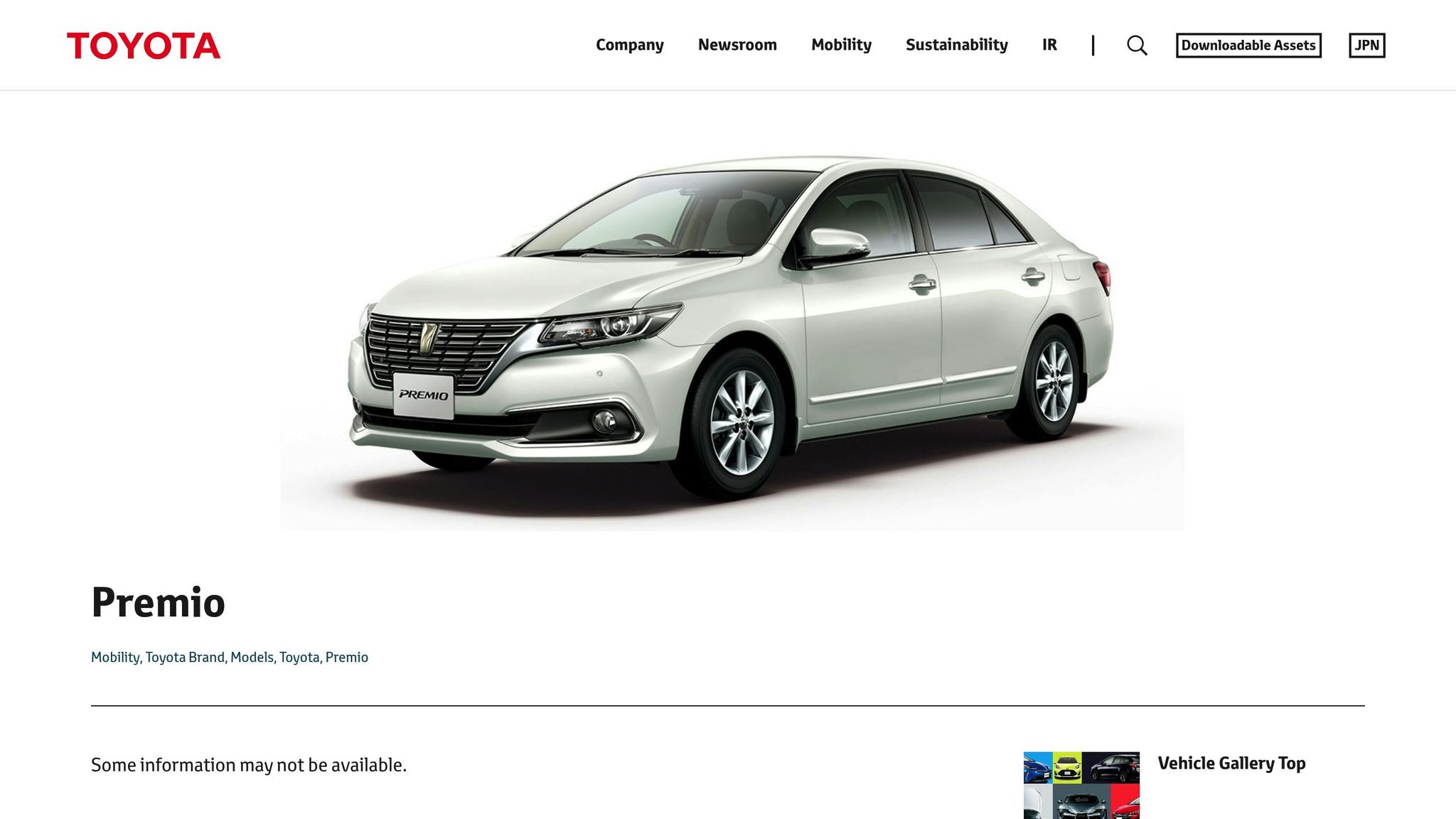
The Toyota Premio is a standout choice for ride-hailing services in Tanzania, combining mid-luxury comfort with cost efficiency. Known for its reliability, this sedan offers a smooth blend of fuel economy, comfort, and durability, making it a practical investment for taxi operators. Let’s take a closer look at why the Premio is a preferred option for Tanzanian ride-hailing.
Fuel Efficiency
Fuel economy is a top priority for any vehicle used in ride-hailing, and the Toyota Premio delivers solid performance in this area. Its range of engine options ensures efficiency for drivers covering long distances daily. For example, the 1.5-liter engine in the Premio T240 achieves up to 35 MPG, while the 1.8-liter and 2.0-liter engines offer 33 MPG and 28 MPG, respectively. Newer models, like the Premio T260, feature improved powertrains, with the 1.8-liter 2ZR-FE engine reaching 37 MPG and the 2.0-liter 3ZR-FAE averaging 32 MPG.
| Engine Model | Fuel Consumption Rate |
|---|---|
| 1.5-liter 1NZ-FE (Premio T240) | 35 MPG |
| 1.8-liter 1ZZ-FE (Premio T240) | 33 MPG |
| 2.0-liter 1AZ-FSE (Premio T240) | 28 MPG |
| 1.8-liter 2ZR-FE (Premio T260) | 37 MPG |
| 2.0-liter 3ZR-FAE (Premio T260) | 32 MPG |
This level of fuel efficiency translates to fewer stops at the pump and lower operating costs, a crucial factor for ride-hailing drivers looking to maximize their earnings.
Durability and Maintenance
The Premio’s reputation for reliability is well-earned. It’s built to handle the diverse and sometimes challenging road conditions in Tanzania, making it a dependable choice for daily operations. Spare parts are widely available and affordable, ensuring minimal downtime for repairs.
Routine maintenance is also budget-friendly. Servicing a Premio typically costs between $30 and $50, covering essentials like engine oil, filters, and brake pads. For example, one owner from East Africa shared that their highest maintenance cost since 2014 was just $200 to replace four shock absorbers. Regular servicing averages around $40, underscoring its affordability.
"Mechanically, it is a car that understands the owner. This means that if you are someone who wants to drive without the worry of spending much on either fuel or service, the Toyota Premio is the car to drive."
– Andrew Tumuhameho
Passenger Comfort
The Premio’s interior is designed with passenger comfort in mind. It offers a spacious cabin that comfortably seats five adults, with generous legroom and headroom. The seats, often upholstered in soft fabric or leatherette, provide excellent support for long rides. The suspension system is finely tuned, ensuring a smooth ride even on uneven roads.
The quiet cabin creates a serene environment, enhancing the overall travel experience. Compared to competitors like the Honda Grace, the Premio often feels more refined and offers a roomier rear passenger area, adding to its appeal for premium ride-hailing services.
"The Toyota Premio is all about comfort with well-padded seats with very comfortable headrests."
– Paul Karingithi, Marketing Communications Guru
Affordability
Despite its premium features, the Toyota Premio remains accessible to ride-hailing drivers. Its combination of low maintenance costs, excellent fuel economy, and high passenger satisfaction allows drivers to offer premium rides at competitive rates. This balance of quality and affordability makes it a smart choice for those looking to enhance their services while keeping operating costs in check.
The Premio’s strong reputation for reliability and comfort makes it an ideal vehicle for markets where customer satisfaction directly impacts earnings. It’s a car that not only meets but exceeds the expectations of both drivers and passengers.
3. Toyota Passo
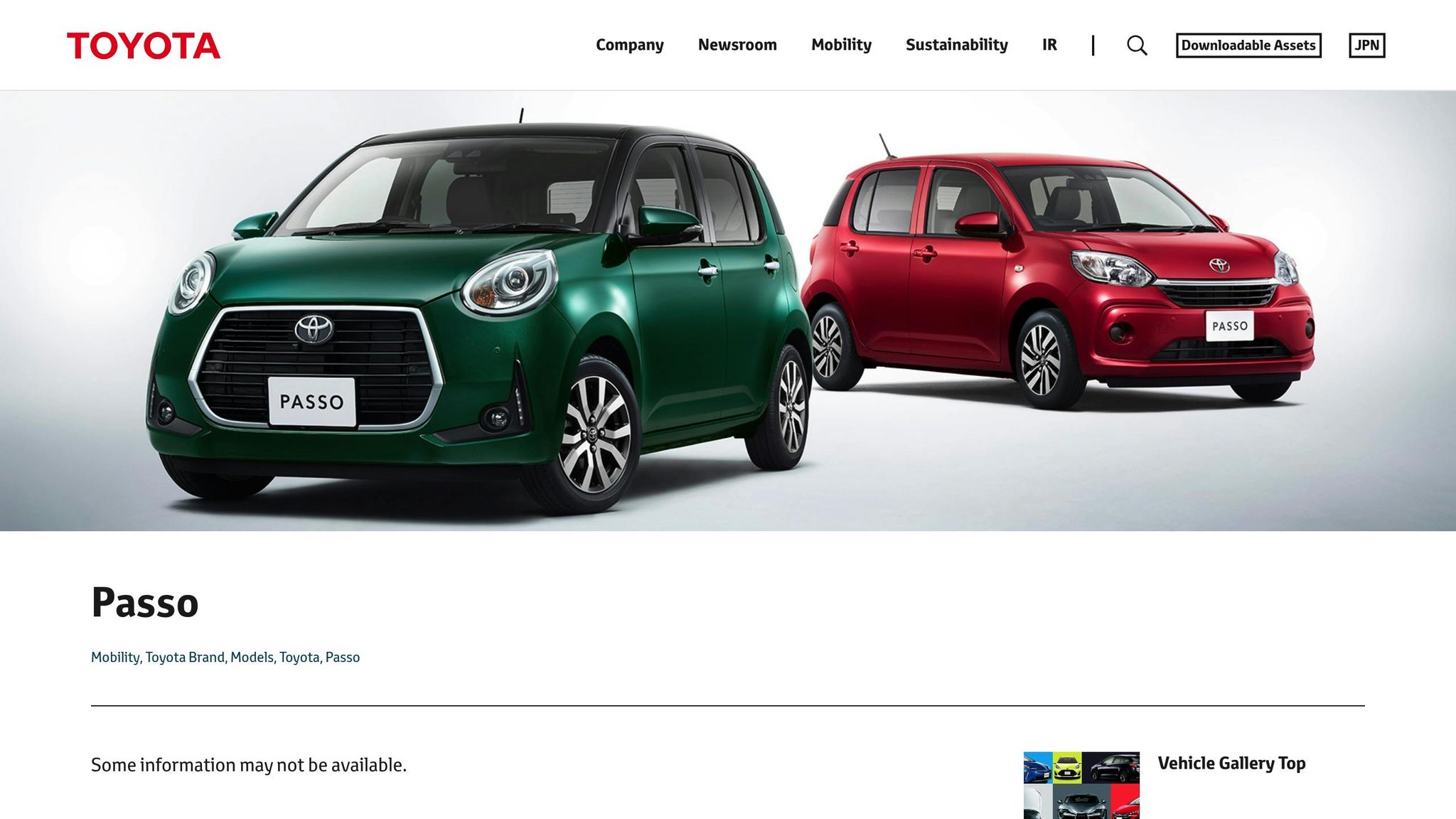
The Toyota Passo is a compact car that’s become a favorite in Tanzania’s ride-hailing industry. Its low fuel consumption and affordable maintenance make it an excellent choice for new drivers entering the market.
Fuel Efficiency
The Toyota Passo is known for its impressive fuel economy. With engine options ranging from 990cc to 1329cc, it can achieve up to 17.4 MPG (28 km/L) at its best. For instance, the 2021 Toyota Passo with a 1.0L petrol engine averages about 15.4 MPG (24.8 km/L), making it a cost-effective option for daily use. Uber driver Alex Baguma shares his experience:
"I will recommend the Toyota Passo as a first time car because of the many advantages it has. I use mine for Uber and its fuel consumption cannot be compared to any car of its classification. When the fuel gauge lights red, I will still drive for approximately five to 10kms before the tank completely runs dry. For a refuel of Shs20,000, I can make five trips before refuelling again, depending on where I am dropping the client. Low consumption and more mileage means I am earning profit."
This level of efficiency helps drivers cut down on fuel costs – one of the biggest expenses in ride-hailing – allowing them to increase their profits.
Affordability
For drivers looking to enter the market, the Toyota Passo is one of the most budget-friendly options. The prices for used models vary depending on the year:
| Model Year | Price Range (TSh) | Price Range (USD) |
|---|---|---|
| 2008-2010 | 8–10 million | $3,400–$4,250 |
| 2011–2014 | 10–13 million | $4,250–$5,525 |
| 2015–2017 | 13–16 million | $5,525–$6,800 |
| 2018–2020 | 16–20 million | $6,800–$8,500 |
Some listings even fall between TSh 3.5 million and TSh 8.8 million ($1,490 to $3,740), making it accessible to drivers with varying budgets. Combined with its fuel efficiency, the Passo offers an affordable way to start or sustain a ride-hailing business.
Durability and Maintenance
In addition to its affordability, the Toyota Passo is designed with simplicity, which translates to lower repair costs. Mechanics are familiar with its straightforward engineering, which helps keep maintenance expenses in check. However, drivers should be mindful of its suspension, which can wear out faster on rough roads. Regular servicing, along with the use of quality oil and clean high-octane fuel, is crucial for maintaining its performance.
Despite these considerations, the Passo remains a reliable option with manageable upkeep costs, making it a practical choice for daily operations.
Passenger Comfort
While compact, the Toyota Passo provides adequate comfort for urban rides, especially for short to medium distances. Its small size makes it easy to navigate through congested city streets and park in tight spaces – an advantage in busy urban areas. That said, its interior is best suited for solo passengers or couples, as larger groups might find it a bit cramped. Still, it strikes a good balance between affordability and basic passenger comfort, appealing to budget-conscious riders.
With its combination of efficiency, affordability, and practicality, the Toyota Passo stands out as a smart option for drivers aiming to maximize their earnings in Tanzania’s competitive ride-hailing market.
4. Nissan Note
The Nissan Note is a compact MPV that combines hybrid e‑Power technology with a roomy interior, making it a smart pick for ride-hailing services.
Fuel Efficiency
The Nissan Note e‑Power stands out for its fuel efficiency. Under ideal conditions, it achieves between 25–30 km/L (59–71 MPG). In urban driving scenarios similar to those in Tanzania, the car averages around 5.7 L/100km (about 41 MPG) in the city and 4.1 L/100km (nearly 57 MPG) on highways. This level of efficiency is a major advantage for ride-hailing drivers, as it helps reduce fuel expenses – a significant operational cost. The hybrid system allows the electric motor to handle most of the city driving, while the petrol engine focuses on charging the battery, optimizing fuel use.
| Model | Engine Type | Fuel Economy (km/L) | Fuel Economy (MPG) |
|---|---|---|---|
| Nissan Note e‑Power | Hybrid | 25–30 | 59–71 |
| Toyota Vitz | 1.0L–1.3L | 18–22 | 42–52 |
| Honda Fit | 1.3L–1.5L | 20–26 | 47–61 |
| Toyota Axio | 1.3L–1.5L | 18–24 | 42–56 |
This efficiency doesn’t just save on fuel – it also makes the vehicle more economical to run overall.
Affordability
While the Nissan Note may come with a higher upfront cost, its reduced fuel consumption leads to significant savings over time. For drivers covering long distances or operating in areas with fluctuating fuel prices, this hybrid’s cost-effectiveness becomes even more appealing.
Durability and Maintenance
The Nissan Note is designed with reliability in mind. Like other hybrids, it performs best when maintained according to the manufacturer’s schedule. Regular oil changes, tire checks, and monitoring essential fluids – such as brake fluid, coolant, and transmission fluid – are key to keeping the vehicle in top shape. Sticking to these maintenance practices and using quality parts ensures the car remains dependable while keeping repair costs manageable.
Passenger Comfort
One of the highlights of the Nissan Note is its spacious and well-thought-out interior. It comfortably seats four adults, with ample headroom for passengers in all seats. Even taller passengers, up to six feet, can fit in the back seat, though knee room might feel slightly limited on longer trips if the seats aren’t adjusted. The car also offers impressive storage flexibility, with 411 liters of boot space when the seats are up and a generous 1,495 liters when they’re folded. While some interior materials may feel less refined, the overall cabin design and smooth ride quality enhance passenger satisfaction. For ride-hailing drivers, this means happier customers and better reviews.
With its combination of hybrid fuel efficiency, spacious interior, and practical storage, the Nissan Note is a strong contender for those looking to lower operating costs while ensuring passenger comfort in Tanzania’s competitive ride-hailing market.
5. Honda Fit
The Honda Fit is a smart choice for Tanzanian ride-hailing operators. Known for its fuel efficiency, reliability, and practical design, it helps drivers keep costs low while maximizing their earnings.
Fuel Efficiency
The Honda Fit stands out for its impressive fuel efficiency. The standard petrol model offers 20–26 km/L (47–61 MPG), while the hybrid version delivers an even better 30–34 km/L (71–80 MPG). In city driving, the petrol model achieves 31–36 MPG, and on highways, it goes up to 36–40 MPG. For drivers covering long distances daily, these numbers can lead to significant savings. While the hybrid model has a higher upfront cost, its fuel savings over time can make it a worthwhile investment.
Affordability
The Honda Fit combines fuel savings with a competitive price tag and low maintenance costs. Used models are available for TZS 15–22 million, making them accessible for many operators. Additionally, its annual maintenance expenses are below the average for subcompact cars, which adds to its long-term affordability.
Durability and Maintenance
Reliability is another strong point of the Honda Fit. It boasts a 4.5 out of 5.0 rating on RepairPal, and Honda as a brand ranks 1st out of 32 car brands with a 4.0 out of 5.0 rating. Consumer Reports also places Honda fourth out of 22 brands in reliability rankings. Its durable engine construction helps prevent major breakdowns, and its straightforward design keeps parts and repairs reasonably priced. The sturdy suspension and balanced ground clearance handle rough roads well, reducing the need for frequent repairs. Plus, models from 2006 onward include a Maintenance Minder system that alerts drivers when servicing is due.
Passenger Comfort
The Honda Fit isn’t just about cost-saving; it also prioritizes passenger comfort. Its standout feature is the "Magic Seat" system, which provides unmatched flexibility for cargo and seating arrangements. Whether it’s a run to the airport or a shopping trip, drivers can easily adapt to passengers’ luggage needs. This versatility not only boosts customer satisfaction but also enhances the vehicle’s resale value. These qualities make the Honda Fit an excellent match for the diverse requirements of ride-hailing services in Tanzania.
6. Suzuki Alto
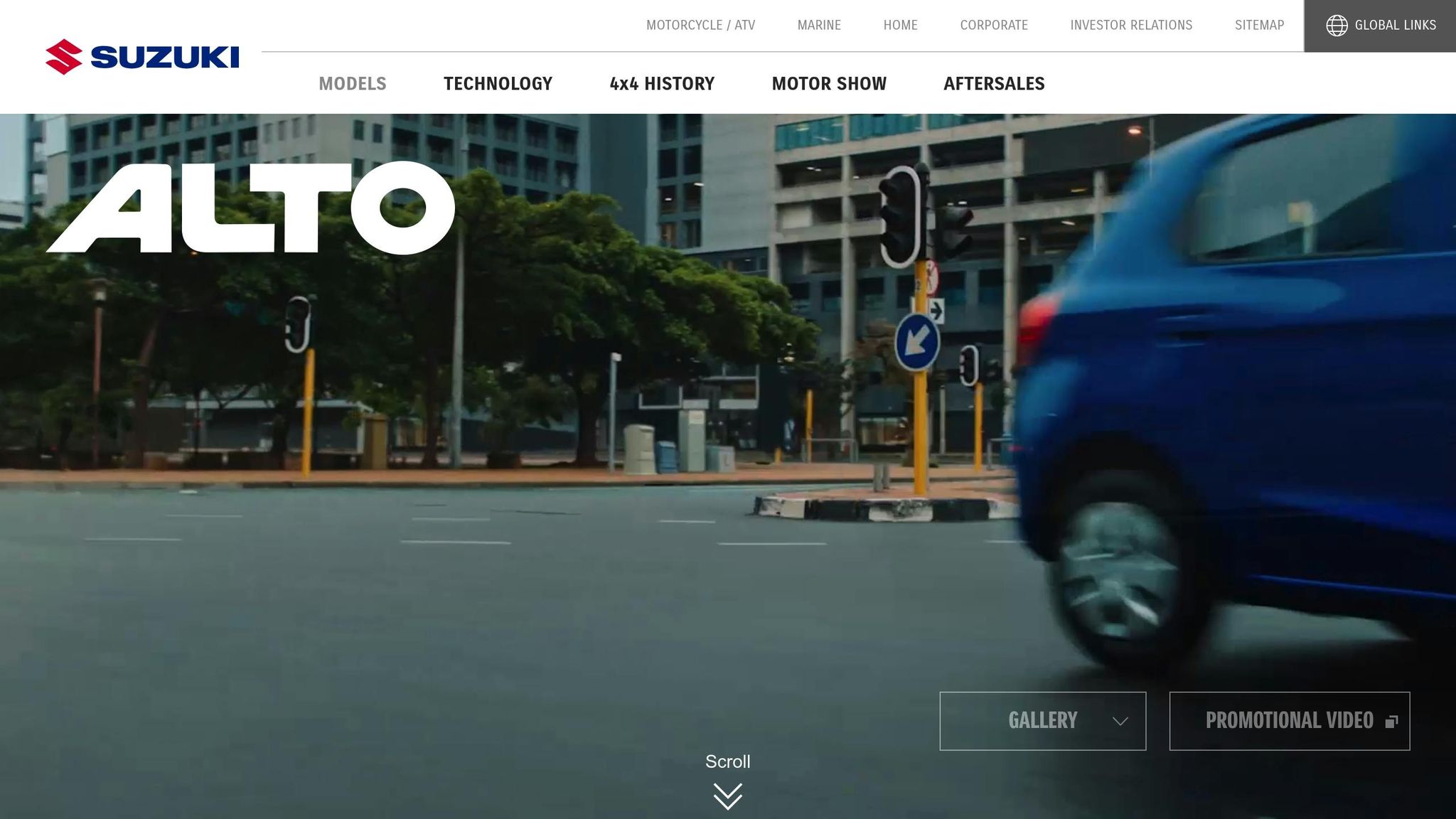
The Suzuki Alto is a standout choice for ride-hailing services in Tanzania, thanks to its impressive fuel efficiency and budget-friendly nature. This compact car is a reliable workhorse, offering a simple design, dependable performance, and low running costs – qualities that make it ideal for drivers aiming to maximize their daily earnings.
Fuel Efficiency
When it comes to fuel economy, the Suzuki Alto is hard to beat. It achieves an impressive 22–26 km/L (52–61 MPG), with fuel consumption typically under 5 liters per 100 km. This efficiency is largely due to its lightweight build and small 0.8L to 1.0L petrol engine. Compared to other popular ride-hailing options, the Alto consistently delivers better mileage.
| Model | Engine Size | Fuel Economy (km/L) |
|---|---|---|
| Toyota Vitz | 1.0L-1.3L | 18–22 |
| Honda Fit | 1.3L-1.5L | 20–26 |
| Toyota Axio | 1.3L-1.5L | 18–24 |
| Suzuki Alto | 0.8L-1.0L | 22–26 |
| Nissan Note e-Power | Hybrid | 25–30 |
For drivers who spend 10–12 hours on the road daily, this kind of fuel efficiency can make a significant difference in profitability. By cutting down fuel expenses, the Alto helps keep overall operating costs in check.
Affordability
The Suzuki Alto is an excellent option for drivers on a budget. New 2025 hybrid models are priced between $8,566 and $9,447, while used models are even more affordable, making it accessible for those starting out in the ride-hailing business. Its modest engine provides enough power for city driving without guzzling fuel, striking a great balance between performance and economy.
Beyond its purchase price, the Alto’s straightforward mechanics translate to lower maintenance costs, making it a practical choice for operators with limited capital.
Durability and Maintenance
The Alto is built to last, offering both reliability and low upkeep expenses. With proper care, its engine can run smoothly for 150,000 to 200,000 miles. Its lightweight design and efficient engine make it especially popular among city drivers who need dependable transportation for daily use.
The maintenance schedule is simple and affordable. New models come with a free inspection at 1,000 km or 1 month, followed by another at 10,000 km or 6 months. Routine maintenance, such as oil changes, is recommended every 5,000 km or 3 months.
To ensure the Alto performs at its best, drivers should follow the manufacturer’s service guidelines, including timely oil changes, air filter replacements, and spark plug checks. Using high-quality oil and genuine Suzuki parts can prevent common issues like overheating or oil leaks. Thanks to its uncomplicated design, repairs are typically less costly and easier to handle compared to larger, more complex vehicles.
Passenger Comfort
While the Suzuki Alto isn’t a luxury car, it provides sufficient comfort for the short to medium-distance trips often seen in urban ride-hailing. Its compact size is perfect for navigating crowded streets and squeezing into tight parking spaces, making it a great choice for individual passengers or couples.
The Alto’s nimble handling and city-friendly design ensure a smooth experience for both drivers and passengers during frequent stops and starts in traffic. However, its smaller cabin may not be ideal for longer trips or passengers carrying large amounts of luggage.
sbb-itb-d9186c2
7. Toyota Vitz
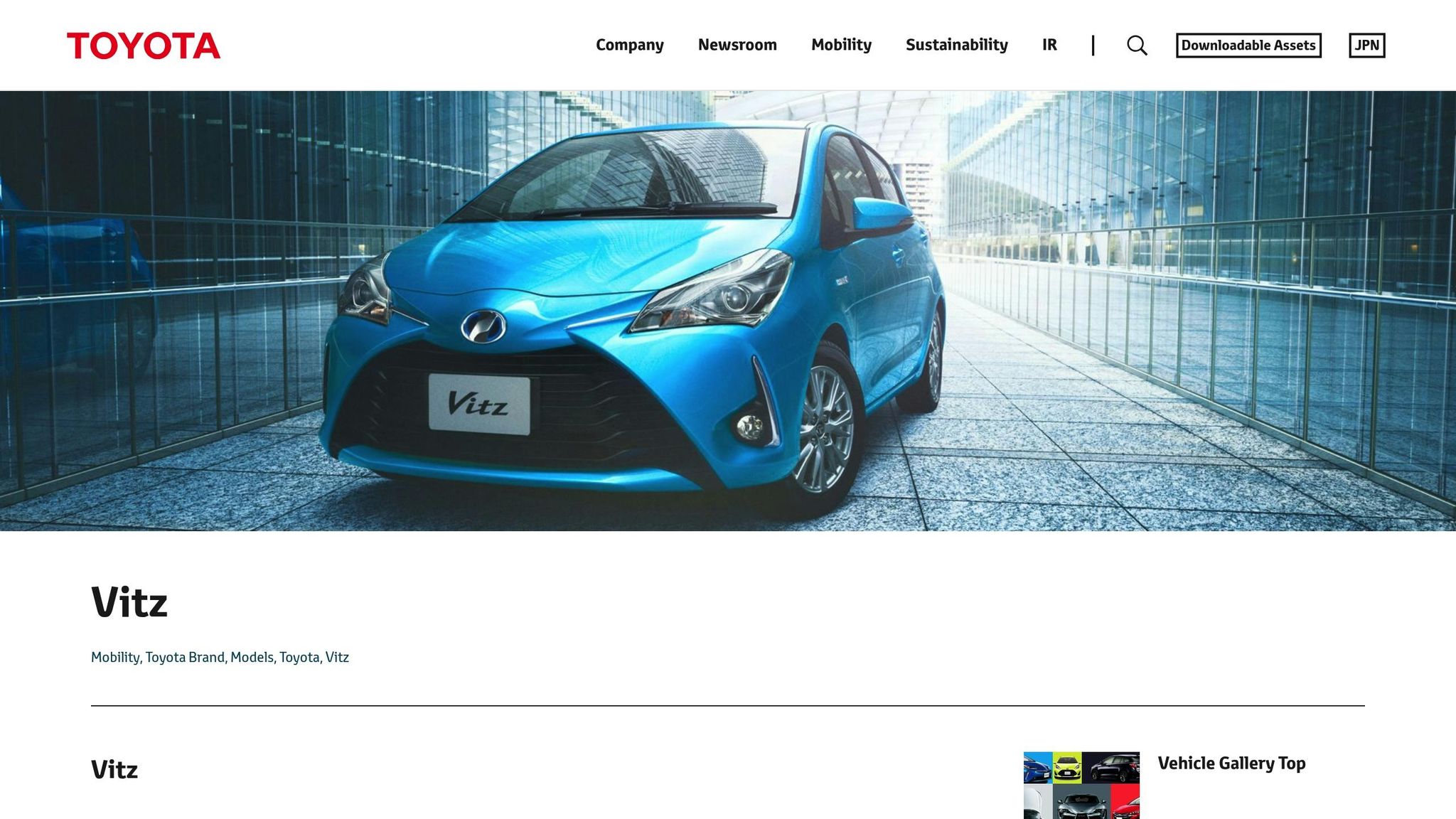
The Toyota Vitz is a compact hatchback that’s a popular choice for ride-hailing in Tanzania. Known for its dependability and excellent fuel economy, it’s an ideal option for drivers who want to keep operating costs low while maximizing their earnings.
Fuel Efficiency
The Vitz stands out with impressive fuel efficiency, consuming just 4.6 liters per 100 kilometers. Powered by the advanced 1NR engine, it achieves a mileage of 20–25 km/L (47–59 MPG), making it a cost-effective choice for daily operations.
Here’s how it compares to similar models:
| Model | Fuel Efficiency (L/100km) |
|---|---|
| Suzuki Celerio | 4.4 |
| Suzuki DZire | 4.5 |
| Toyota Vitz | 4.6 |
| Renault Kwid | 4.7 |
| Suzuki Swift | 4.8 |
| Suzuki S-Presso | 4.9 |
For even better efficiency, the XR AMT model reduces consumption to 4.2 liters per 100 kilometers, while manual versions use about 4.4 liters per 100 kilometers. This makes the Vitz not only economical but also a practical choice for drivers aiming to save on fuel.
Affordability
The Toyota Vitz offers great value for Tanzanian drivers. Pre-owned models start at TZS 1,900,000, while a brand-new 2025 Vitz is available from R 178,800 (around $9,900). Its compact size and fuel efficiency make it easy to manage operating costs, ensuring steady profits even during times of fluctuating fuel prices.
Durability and Maintenance
The Vitz is celebrated for its reliability, making it a dependable partner for daily ride-hailing. Maintenance is straightforward and affordable, with spare parts readily available across Tanzania due to its shared components with other Toyota models like the Platz and Ractis.
Typical maintenance costs include:
- Minor service: TZS 80,000 to TZS 120,000
- Major service: Approximately TZS 250,000
Routine maintenance involves engine oil changes every 7,500 km or six months, air filter replacements every 15,000–20,000 km, and spark plug changes every 20,000 km or 12 months. For models from 2013 onward, adjusting the ground clearance is recommended to handle Tanzania’s varied road conditions better.
Passenger Comfort
The Vitz isn’t just about performance and savings; it also offers decent comfort for passengers on short to medium-distance trips. Its compact design makes it easy to navigate through traffic and park in tight spaces. However, the cabin might feel a bit snug for larger groups or passengers with lots of luggage.
"It’s fuel-efficient, easy to park, and reliable. Thank you, EVERYCAR.jp, for such a great car!"
– Aisha M., Dodoma
Its responsive steering and nimble handling make it an excellent choice for both city streets and rural roads, minimizing driver fatigue during stop-and-go traffic. This blend of practicality and comfort keeps the Vitz a favorite among Tanzanian ride-hailing drivers.
8. Mazda Demio
The Mazda Demio is a 5-door, 5-seater hatchback that has become a popular choice among ride-hailing drivers in Tanzania. Known for its efficiency and low running costs, it’s a practical option for drivers aiming to maximize earnings while keeping expenses in check.
Fuel Efficiency
When it comes to fuel economy, the Mazda Demio is hard to beat. It boasts fuel consumption as low as 4.9 liters per 100 kilometers, thanks to Mazda’s Skyactiv technology and lightweight construction. The Demio comes in both diesel and petrol variants:
- Diesel version: Features a 1.5L Skyactiv-D engine, delivering an impressive average of 30 km/L.
- Petrol versions: Equipped with 1.3L or 1.5L Skyactiv-G engines, achieving 20–24 km/L depending on driving conditions and transmission type.
Here’s how the Demio stacks up against other popular ride-hailing vehicles:
| Car Model | Fuel Consumption (L/100km) |
|---|---|
| Mazda Demio | 4.9 |
| Suzuki Swift | 5.1 |
| Honda Fit | 5.5 |
| Toyota Vitz | 6.2 |
This exceptional fuel efficiency not only reduces fuel expenses but also enhances the car’s overall value.
Affordability
The Mazda Demio is an economical choice, especially when considering long-term operational costs. While the initial purchase price varies depending on the model year and condition, its low fuel consumption helps offset the investment over time, making it a smart pick for ride-hailing drivers focused on profitability.
"The Demio stands out for being both efficient and cost-effective in the long term, particularly for those in the ride-hailing space."
Durability and Maintenance
Mazda is known for building reliable vehicles, and the Demio is no exception. Regular maintenance is key to keeping the car in top shape and avoiding expensive repairs. Maintenance costs are reasonable, with typical service expenses ranging from KSh 5,000 to KSh 30,000 (about $37 to $222). Below are common maintenance intervals and costs:
- Oil changes: Every 5,000–10,000 km (KSh 5,800–6,500 or $43–$48)
- Tire rotation: Every 8,000–10,000 km (KSh 1,500 or $11 for labor)
- Brake checks: Every 10,000–15,000 km (KSh 1,500 or $11 for labor)
For used models, it’s best to opt for versions from 2007 onward, as they come with improved safety features. Additionally, choosing a manual transmission or newer automatic gearboxes can help avoid the transmission issues seen in pre-2014 models. Early models may also be prone to rust, so regular inspections are essential.
Passenger Comfort
The compact design of the Demio makes it perfect for navigating Tanzania’s busy streets while offering a comfortable ride. The front seats are well-cushioned, though rear passengers might find legroom a bit tight on longer trips. Its nimble handling and small size make parking in crowded areas easier, striking a balance between practicality and comfort for both urban rides and longer rural journeys.
9. Toyota Axio
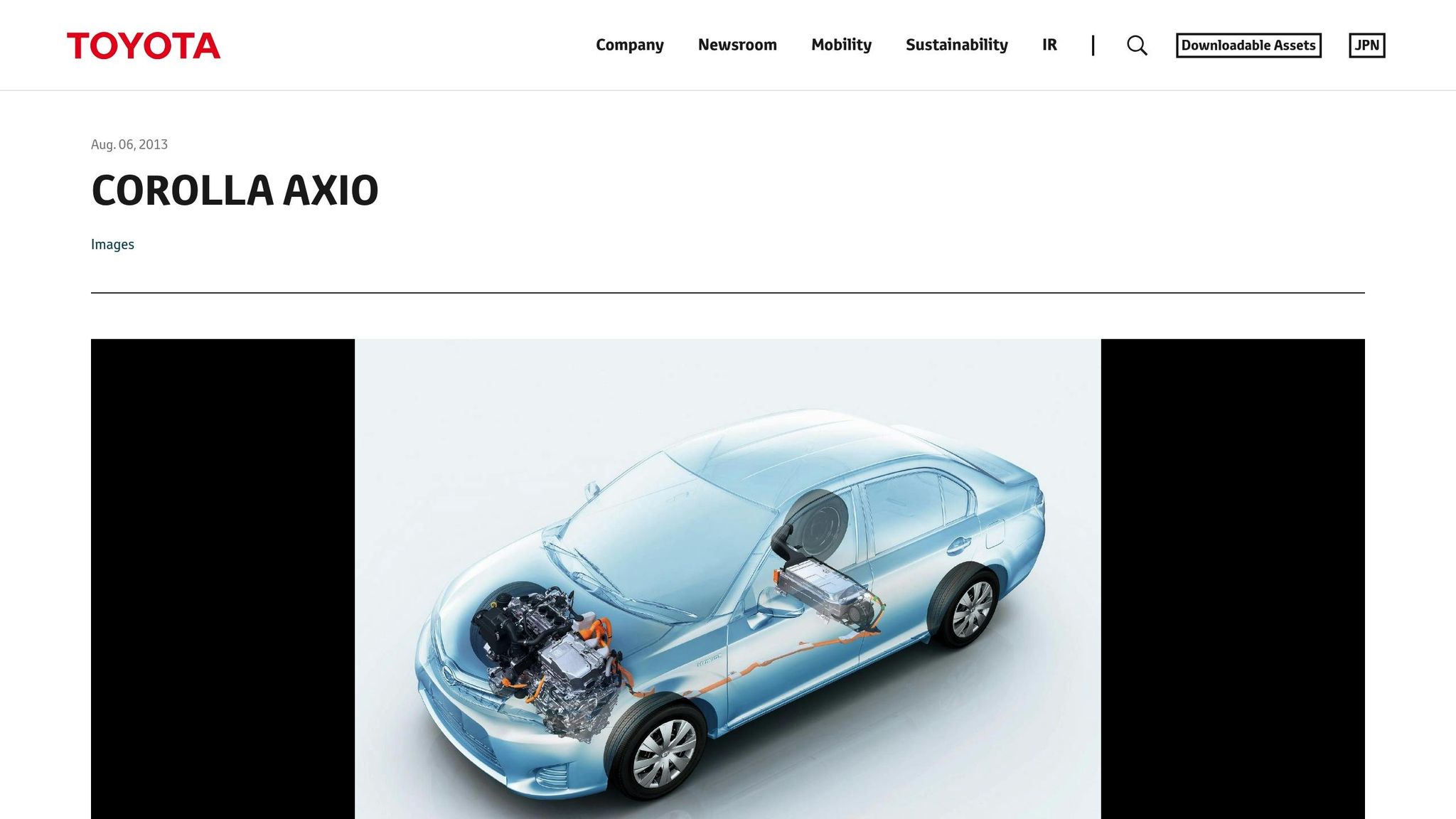
The Toyota Axio is a compact sedan that has won the favor of Tanzanian ride-hailing drivers, thanks to its excellent fuel economy, reliable performance, and comfortable design.
Fuel Efficiency
The Toyota Axio is known for its impressive fuel efficiency, delivering between 18–24 km/L, depending on driving conditions and engine type. It comes in both petrol and hybrid variants. The hybrid version typically achieves 16–23 km/L. To see how the Axio compares to other popular models, take a look at this breakdown:
| Model | Engine Size | Fuel Economy (km/L) | Price Range (TZS) |
|---|---|---|---|
| Toyota Axio | 1.3L–1.5L | 18–24 | 20M–30M |
| Honda Fit | 1.3L–1.5L | 20–26 | 15M–22M |
| Toyota Vitz | 1.0L–1.3L | 18–22 | 12M–18M |
| Suzuki Alto | 0.8L–1.0L | 22–26 | 10M–15M |
While the Axio may not top the list in terms of fuel economy, it holds its own with a strong balance of efficiency and performance, making it a practical choice for both city and highway driving.
Affordability
Used Toyota Axio models typically range from TZS 20M to 30M, placing them in the mid-range price bracket. While it may cost more upfront compared to smaller options like the Suzuki Alto, the Axio’s durability and fuel savings make it a worthwhile investment. Hybrid models, though slightly pricier initially, can significantly reduce fuel expenses over time, offering long-term value.
Durability and Maintenance
The Axio’s reputation for durability is well-earned, with a design that minimizes the need for frequent repairs.
"It has been a strong and sturdy car that never leaves us stranded on the road." – Brass
Its compatibility with local roads, availability of spare parts, and the expertise of local mechanics further enhance its appeal for commercial use. The hybrid system, often backed by warranties up to 150,000 miles, reflects Toyota’s confidence in the car’s longevity. Additionally, the hybrid setup reduces strain on the gasoline engine, helping to keep maintenance costs manageable.
Beyond its reliability, the Axio also prioritizes passenger comfort, making it a favorite among both drivers and riders.
Passenger Comfort
The Toyota Axio stands out for its focus on passenger comfort. Its roomy cabin provides ample legroom, especially for rear-seat passengers. The suspension is tuned to absorb bumps and uneven surfaces, ensuring a smooth ride.
"I love the comfortable ride and spacious interior. It’s perfect for my family." – Mary, Kenya
Standard features like air conditioning, power windows, and central locking add to the convenience. The spacious interior is versatile enough to accommodate both passengers and luggage, making it ideal for short city trips and longer journeys alike. With dimensions of 1,695 mm in width and 4,390 mm in length, the Axio strikes a great balance – compact enough for easy parking in crowded areas, yet spacious enough to ensure a comfortable ride. This combination of maneuverability and interior space makes the Axio a smart choice for navigating Tanzania’s diverse roads.
10. Hyundai Accent
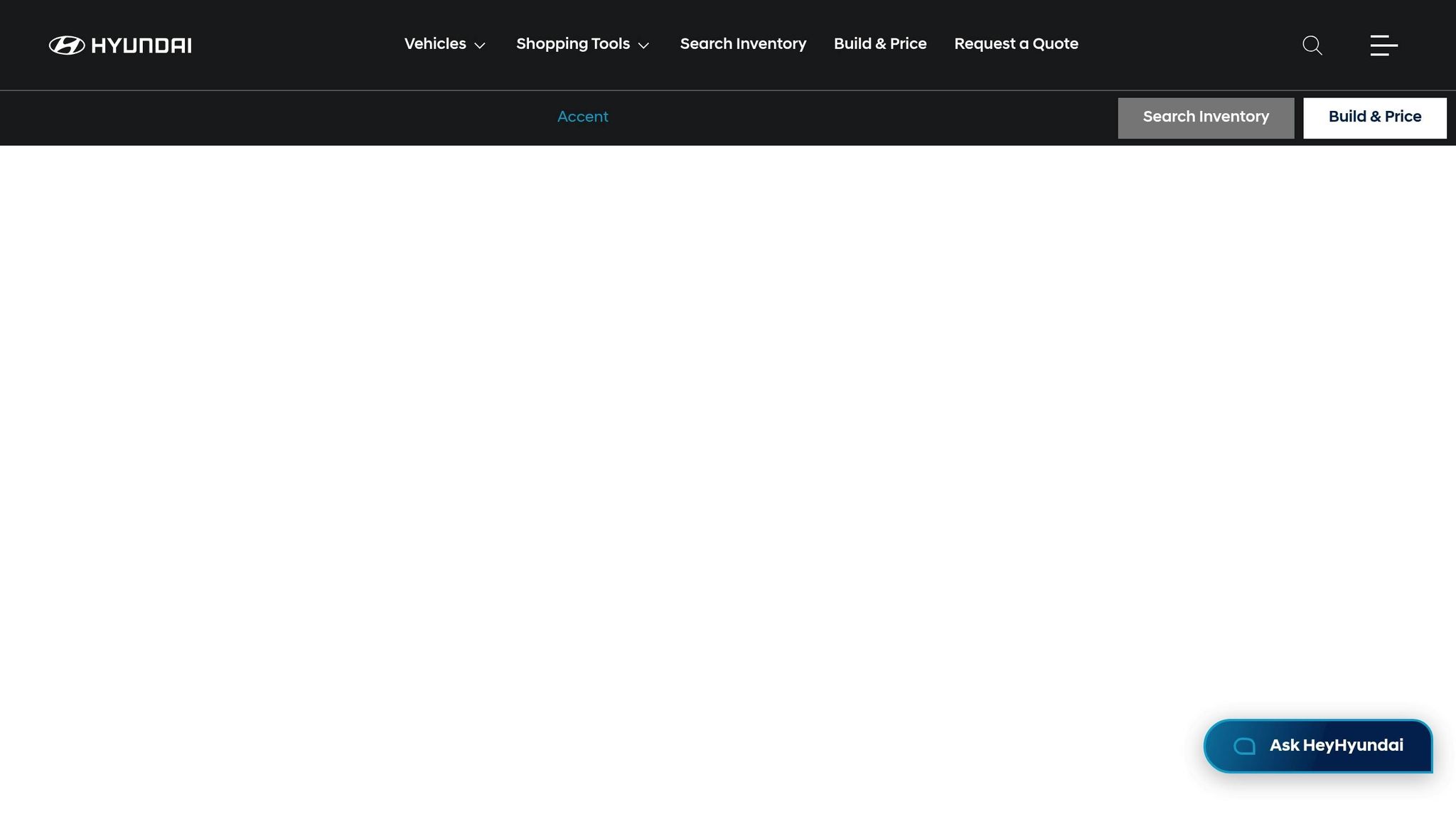
The Hyundai Accent wraps up our list as a dependable compact sedan, offering a mix of solid fuel efficiency and low maintenance costs, making it a practical choice for ride-hailing drivers in Tanzania.
Fuel Efficiency
The 2025 Hyundai Accent performs well in terms of fuel economy, delivering around 5.1L/100km under ideal conditions. That translates to about 28 MPG for city driving and 35 MPG on highways. In real-world scenarios, you can expect approximately 5.8L/100km in the city and 4.7L/100km on the highway. Simple habits like maintaining steady speeds and checking tire pressure regularly can slightly improve these numbers, though heavy use of air conditioning might increase fuel consumption.
Affordability
One of the standout features of the Hyundai Accent is its affordability. Over a five-year period, maintenance costs are estimated at about $2,240 (converted from AED 8,400), and its fuel efficiency translates to roughly 18.8 km/L in city conditions. This combination of low running costs and efficient fuel use makes it a budget-friendly option for ride-hailing operators.
Durability and Maintenance
Hyundai vehicles, including the Accent, are known for their durability. Over the first 10 years, maintenance and repair costs average around $7,050 – about $1,253 less than the industry standard. Many owners report keeping their Accents for seven years or longer. While some users have noted occasional issues, such as air conditioning malfunctions or minor electrical problems, staying on top of manufacturer recalls and service bulletins can help maintain the car’s reliability. The 2025 Hyundai Accent Hatchback has earned a 4.1 out of 5-star rating, with particularly high scores for value for money (4.5/5) and reliability (4.3/5).
Passenger Comfort
Comfort is another area where the Hyundai Accent delivers. With seating that supports long hours of driving and a trunk capacity of 396 liters, it’s well-suited for daily ride-hailing needs. Features like air conditioning and power windows ensure a pleasant experience for passengers, meeting basic expectations for comfort and convenience.
Compliance with Regulations
For ride-hailing drivers, ensuring the vehicle meets local regulations is essential. The Accent’s compliance depends on specific criteria, such as engine size and model year. For instance, Uber Tanzania requires vehicles to be from 2003 or newer, and some service categories mandate an engine size below 1300cc. The Accent’s 1.6L engine might exceed these limits for certain services, so drivers should verify local requirements before making a purchase.
Advantages and Disadvantages
When selecting the right vehicle for ride-hailing services in Tanzania, each model comes with its own set of strengths and weaknesses. These factors influence costs, day-to-day operations, and passenger experience. Here’s a closer look at what each category offers.
Compact cars such as the Toyota Vitz, Honda Fit, and Suzuki Alto are known for their fuel efficiency and ease of navigation in urban areas. Among these, the Suzuki Alto is the most affordable, with used models priced between TZS 10M-15M, offering an impressive fuel economy of 22-26 km/L. However, their compact size can be a drawback, as they provide less room for passengers and luggage, which might be an issue for longer trips or airport runs.
Mid-size sedans like the Toyota Corolla, Premio, and Axio strike a balance between comfort and operational costs. For instance, the Toyota Axio, priced at TZS 20M-30M, is well-suited for longer journeys, offering a fuel efficiency of 18-24 km/L. While these sedans are versatile and meet most ride-hailing demands, their higher purchase price can be a hurdle for those with tighter budgets.
Hybrid models such as the Nissan Note e-Power cater to the premium segment, with pre-owned units costing between TZS 25M-35M. These vehicles deliver excellent fuel savings, especially for drivers covering significant distances. However, the initial investment and the complexity of hybrid systems may deter operators who prioritize immediate returns over long-term savings.
When it comes to maintenance and reliability, Toyota vehicles outperform competitors. They are easier to service, have lower maintenance costs, and retain better resale value. Toyota’s powertrain design is well-suited for Tanzania’s high temperatures, and their models generally have lower insurance premiums compared to brands like Nissan, which, while technologically advanced, can be more expensive to insure.
Road adaptability is another important factor. Compact cars like the Vitz and Alto excel on paved city roads but struggle on rougher, unpaved routes. Meanwhile, vehicles like the Toyota Axio, with its higher ground clearance, offer more flexibility for varied road conditions. However, none of these models can match the rugged performance of 4×4 vehicles on challenging terrain.
To make things easier, here’s a quick comparison:
| Model | Purchase Price (TZS) | Fuel Economy (km/L) | Ideal For | Key Advantage | Main Drawback |
|---|---|---|---|---|---|
| Suzuki Alto | 10M-15M | 22-26 | Budget drivers | Low running costs | Limited passenger space |
| Toyota Vitz | 12M-18M | 18-22 | City driving | Easy to maneuver | Struggles on rough roads |
| Honda Fit | 15M-22M | 20-26 | Small families | Roomy interior | Higher maintenance costs |
| Toyota Axio | 20M-30M | 18-24 | Long-distance travel | Comfortable and durable | Higher upfront cost |
| Nissan Note e-Power | 25M-35M | 25-30 | Eco-conscious drivers | Excellent fuel efficiency | Complex hybrid system |
All models meet the seating requirements for ride-hailing services.
Profitability is a key consideration for any ride-hailing business. Fuel, insurance, and maintenance expenses directly affect profit margins. Budget-friendly options like the Suzuki Alto maximize earnings per trip thanks to their low running costs. On the other hand, premium choices like the Nissan Note e-Power are better suited for drivers aiming for long-term fuel savings, even if it means a higher initial expense.
The availability of spare parts is another critical element. Toyota has a well-established parts network in Tanzania, making repairs quicker and more affordable. In contrast, less common brands may lead to longer downtimes, which can hurt a driver’s earning potential.
Lastly, driver comfort plays a significant role in service quality. For long shifts, models like the Toyota Premio and Axio offer better seating ergonomics and air conditioning, helping reduce fatigue and ensuring a better experience for both drivers and passengers. These factors not only impact the driver’s well-being but also contribute to higher service standards.
Conclusion
When it comes to choosing vehicles for Tanzania’s ride-hailing market, it’s all about balancing affordability, fuel efficiency, and passenger comfort. Based on our analysis, the Toyota Corolla and Toyota Axio stand out as top picks. They offer durability and consistent performance, making them a great match for the country’s diverse road conditions.
For those keeping a close eye on costs, the Suzuki Alto emerges as a budget-friendly option. However, its compact size might make it less ideal for longer trips where passenger space is a priority.
If you’re looking to embrace eco-friendly transportation, the Nissan Note e-Power offers a forward-thinking solution. While its upfront cost is higher, the long-term fuel savings make it a smart choice for operators in Dar Es Salaam, where demand for greener ride-hailing options is on the rise. This aligns with broader market trends favoring sustainability.
The potential here is substantial. Tanzania’s ride-hailing market is projected to hit $141.27 million by 2025, with an annual growth rate of 9.82% through 2030. This growth spells opportunity for both individual drivers and fleet operators.
As the market evolves, hybrid and electric vehicles are likely to play a bigger role. Models like the Nissan Note e-Power could become increasingly relevant. Additionally, staying informed about LATRA’s fare and commission regulations will help operators keep costs in check.
FAQs
What should I consider when selecting a car for ride-hailing or taxi services in Tanzania?
When selecting a car for ride-hailing services like Uber, Bolt, or even traditional taxis in Tanzania, it’s important to prioritize fuel efficiency, low maintenance costs, and durability. These factors play a big role in keeping your operating costs low and your earnings high. At the same time, passenger comfort and safety should not be overlooked, as they can significantly influence customer satisfaction and the reviews you receive.
It’s also crucial to ensure the vehicle meets local regulations and is well-suited for Tanzanian road conditions. Look for models that strike a good balance between affordability and reliability to meet the needs of both drivers and passengers.
What are the fuel efficiency and cost-saving benefits of hybrid cars like the Nissan Note e-Power for ride-hailing drivers?
Hybrid cars, such as the Nissan Note e-Power, are known for their impressive fuel efficiency, making them a great option for ride-hailing drivers looking to cut down on gas costs. These vehicles can lower fuel expenses by 20% to 50% compared to traditional gasoline-powered cars – a big plus for drivers who spend hours on the road every day.
But the benefits don’t stop there. Hybrids typically have lower maintenance costs as well, thanks to reduced wear on parts like brakes and engines. Over time, these savings can make a noticeable difference, increasing profits for drivers working with services like Uber, Bolt, or even traditional taxi companies. For those aiming to keep operating costs low while maximizing earnings, investing in a hybrid vehicle is a practical choice.
Why is the Toyota Corolla a popular choice for Uber and Bolt drivers in Tanzania?
The Toyota Corolla is a go-to pick for Uber and Bolt drivers in Tanzania, thanks to its great fuel economy, affordable upkeep, and dependable performance. These qualities make it a cost-effective choice for drivers aiming to keep expenses low and profits high.
Beyond that, the Corolla navigates local roads with ease and provides a smooth, comfortable experience for passengers – an essential factor in the ride-hailing business. Its reasonable price tag and the widespread availability of spare parts add to its practicality, making it a solid investment for drivers in the area.
Related posts
- Discover Tanzania’s Most Economical Cars for Daily Commuting
- Best used cars in Tanzania 2025
- Car prices in Dar es Salaam
- Top 5 Budget Cars Under TSh 20 Million in Tanzania

